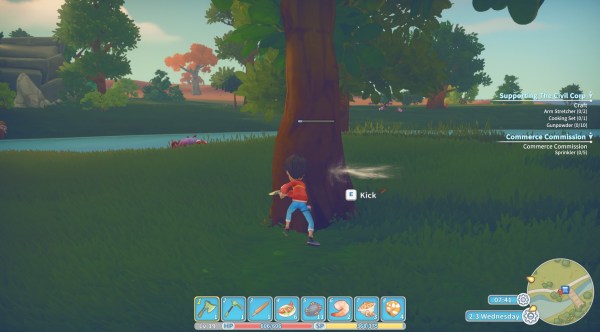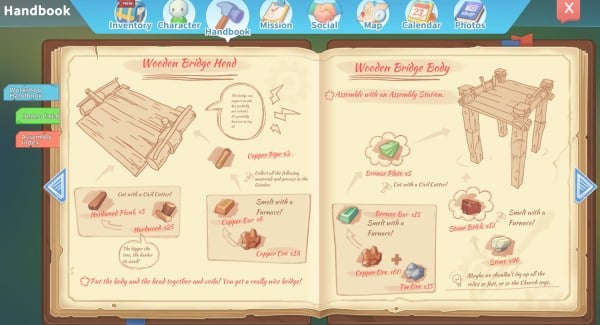My Time at Portia on PC
If there’s one thing My Time at Portia understands, it’s growth. From the very moment you start your new life, everything you do always feels like you’re moving somewhere. These tasks, no matter how meager, always find a way to lead you to some bigger goal.
My Time at Portia doesn’t waste any time holding your hand. Right when you leave the boat at the start of the game, you’re brought over to your father’s old workshop and left with a note explaining your inheritance. After a few tutorials about your new life as a builder, you’re pretty much left to your own devices.
There’s a lot of work that needs to get done, and you start out with nothing but your measly work station. Your task is to be a builder, which entails crafting items out of all sorts of raw resources. Everything falls to you to craft your own tools and get your new career up and running.
You’ll be spending plenty of time at your worktable and assembly station building all sorts of inventions to cash in for commissions you can sign up for. For the most part, the daily grind usually entails waking up in the morning and collecting materials to use to create tools or other items you can sell.
Progression is fairly simple, with you taking up simple tasks for money and using it to expand your house and land or construct new buildings, such as coops and stables. You’ll wake up every morning and have a whole day to get things done. You’re limited to a certain amount of stamina, which drains whenever you use tools, foraging materials, or partaking in other activities.
Unlike some games, however, My Time at Portia doesn’t wind up heading into the same pitfall of repeating the same monotonous task for some quick coin. Although you’re labeled as a builder, there are plenty of other ways you can earn a living.
While you can take commissions from the Commerce Guild in town, you can also grow plants, tend to livestock, mine, and even fish. My Time at Portia offers a large map set in a post-apocalyptic setting, complete with ruins and other secret caverns you can raid for rare materials. There are also enemies you can fight and loot for materials, although combat is fairly straightforward and simplistic at best.

The game piles on plenty of work to keep you busy, and you’ll be constantly shuffling between duties to get your jobs done. Just when you think you’ve finally cleared your schedule, you’ll probably get some mail adding another chore to your ever-expanding to-do list the next day.
The real fun for me came from with mining, as it’s where you can find items called data discs that you can turn in for blueprints to craft more building tools. You can also salvage treasure, which can range from furniture you can place around your home to parts for crafting.
While you’re always swamped with tasks, your journal makes it easy to keep track of what needs to be done, items to create, and materials you need to find. All the information is stored right within the menus, so you’ll spend more time finishing tasks instead of forgetting them.
As you continue to work, you will level up and earn points you can use to increase certain attributes on your skill chart. These perks can range from more stamina and attack power to more relationship points when giving gifts or talking to townsfolk. You can prioritize which perks you want first and come back to the others later.
Despite the countless tasks stacked on my plate, I never felt any real pressure. My Time at Portia finds a way to respect your time and lets you live your life at your own pace. Sure, some commissions have a certain time limit, but you’ll always have more than enough time to get things done.
However small the task I was handling, it always felt like I was achieving something. What started out with me chopping trees and breaking boulders eventually led to my first furnace. A bit further on, I’d managed to build stations that could create new materials I needed, giving me more time to pursue another task.
Not soon after, I was already looking into building my first coop to house chickens. Everything that I’d been doing so far led to my personal growth, thanks to my own efforts. My Time at Portia never pushes anything on you but, rather, presents options you choose to build your own life.

There are plenty of things you can accomplish, even by focusing on each task one at a time. Focusing on one commission will eventually lead to bigger, better jobs that not only pay more cash, but open up new islands or other useful features, such as fast traveling.
During moments when you aren’t working, you can mingle with the townsfolk in Portia. The game’s whimsical art style and soundtrack complement the many different personalities you’ll meet in the town. Portia is brimming with life, and you’ll always see people running around, attending to their daily schedules.
There are over a handful of different townspeople you can befriend by talking to them and giving them gifts. Heck, you can even punch them in the face in some bizarre sparring mini-game. They’ll also provide you with work occasionally, which is a great way to get on their good side. Attending the seasonal festivals and other celebrations are also fun ways to mix up your busy schedule, giving you a few days of play and time to socialize with others.
When you’re ready, you can even take your relationship with a special someone to the next level in My Time at Portia. There are some townspeople that you can woo, which can eventually lead to marriage. The work doesn’t stop once you’ve tied the knot, but there are some nifty perks you get depending on who you wed.
My Time at Portia isn’t too technically demanding, and I had no trouble running it at high graphics with a mid-range laptop. Moreover, there weren’t any game-breaking issues or annoying control schemes during my playthrough, but there were moments when some of the sound effects and voice acting feel like it cuts off.
You can choose to play with your keyboard and mouse, but you can also hook up a controller. My Time at Portia actually has a dedicated control scheme for the DualShock 4. That said, both options work fine, and the control scheme basically boils down to your personal preference.
My Time at Portia cultivates hard work and pays it off with a sense of progression and achievement. When you aren’t searching for materials or crafting a new gadget, you’re off cavorting at festivals or bonding with the friendly townsfolk. There’s always something waiting for you at Portia, and it pulls you back in every time.
